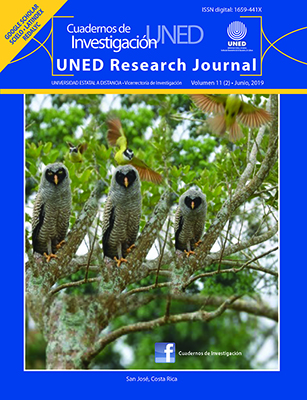The first 10 years of UNED Research Journal: bibliometrics of subjects, authors and institutions
DOI:
https://doi.org/10.22458/urj.v11i2.2404Keywords:
open access, scientific journals, historical trends, scientific publication, LatinamericaAbstract
Introduction: Costa Rica is the Central American country with the most bibliometric studies, however, very few on the historical trends of particular academic journals. Objective: We analyze the statistical trends of the first decade of the journal Cuadernos de Investigación UNED, considering four topics: who publishes, what they publish, how trends have varied over time and what we can expect in the future. Results: The number of frames per article was high at the beginning, then lower, oscillating stably between 2 and 3. The number of figures per article ranges from 2 to 5. The articles have tended to be shortened. The number of authors per article ranges from 2 to 3. Authors have oscillated between a third and a half. The six people with the highest total number of articles published are from the Universidad Estatal a Distancia (UNED), followed by the Universidad de Costa Rica (UCR); half, women. Articles on Costa Rica predominate, followed a long way by the rest of Latin America, Africa and Asia. Articles from Costa Rica have been quadrupled. As for the country of the authors, Costa Rica dominates strongly. The institutions that predominate as sources of articles are the UNED, UCR and the National University of Costa Rica (UNA). UNED has been stable, UCR every 5 years seems to increase, Universidad Nacional de México (UNAM) has decreased. Those who publish about Costa Rica are Costa Rican authors. Increase of articles in Spanish is more marked and constant. Conclusion: The historical patterns coincide with that of other scientific journals such as Tropical Biology that, although published in small countries, are inserted in the much wider world of international science.
References
Bunge, M. (2007). Diccionario de Filosofía. Madrid, España: Siglo XXI Editores.
Carvajal-Angulo, E., & Matamoros-Solís, L. (2012). Análisis bibliométrico de la Revista Costarricense de Psicología, periodo 2001-2011. A propósito de los 30 años de su creación. Revista Costarricense de Psicología, 31, 1-2, 1-20.
Filippo, D. de, Córdoba-González, S., & Sanz-Casado, E. (2016). Bibliometría de la colaboración e impacto de la Revista de Biología Tropical (Web of Science 2003-2012). Revista de Biología Tropical, 64(1), 147-156. DOI: 10.15517/rbt.v64i1.18241
Fine, I., & Shen, A. (2018, 8 de marzo). Perish not publish? New study quantifies the lack of female authors in scientific journals. The Conversation. Recuperado de http://theconversation.com/perish-not-publish-new-study-quantifies-the-lack-of-female-authors-in-scientific-journals-92999
García G., J. (2009). Breve historia de la Escuela de Biología de la Universidad de Costa Rica (1957-2009). Revista de Biología Tropical, 57(1), 1-14.
Monge-Nájera, J., & Díaz, L. (1988). Thirty-five years of Tropical biology: a quantitative history. Revista de Biología Tropical, 36(2B), 347-359.
Monge-Nájera, J., & Ho, Y. S. (2016). Bibliometry of the Revista de Biología Tropical / International Journal of Tropical Biology and Conservation: document types, languages, countries, institutions, citations and article lifespan. Revista de Biología Tropical, 64(3), 1223-1235. DOI: 10.15517/rbt.v64i3.22142
Nielsen-Muñoz, V., Azofeifa-Mora, A. B., & Monge-Nájera, J. (2012).Bibliometry of Costa Rica biodiversity studies published in the Revista de Biología Tropical/International Journal of Tropical Biology and Conservation (2000-2010): the content and importance of a leading tropical biology journal in its 60th Anniversary. Revista de Biología Tropical, 60(4), 1405-1413. DOI: 10.15517/rbt.v60i4.2043
Seas, C. (2019). Reseña histórica: Los primeros diez años de Cuadernos de Investigación UNED. UNED Research Journal, 11(2), 9-13.
Published
How to Cite
Issue
Section
License
Note: This abstract contains an incorrect copyright due to technical issues. Authors who publish with this journal agree to the following terms: Authors retain copyright and grant the journal right of first publication with the work simultaneously licensed under a Creative Commons Attribution License that allows others to share the work with an acknowledgement of the work's authorship and initial publication in this journal
All journal contents are freely available through a CC BY 4.0 license.
CC BY 4.0 is a Creative Commons: you can copy, modify, distribute, and perform, even for commercial reasons, without asking permission, if you give appropriate credit.
Contents can be reproduced if the source and copyright are acknowledged according to the Open Access license CC BY 4.0. Self-storage in preprint servers and repositories is allowed for all versions. We encourage authors to publish raw data and data logs in public repositories and to include the links with all drafts so that reviewers and readers can consult them at any time.
The journal is financed by public funds via Universidad Estatal a Distancia and editorial independence and ethical compliance are guaranteed by the Board of Editors, UNED. We do not publish paid ads or receive funds from companies.
